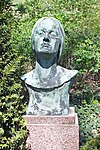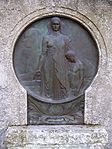Josef Mágr
Josef Mágr (born September 17, 1861 in Mutowitz , Bohemia , † June 18, 1924 in Leipzig ) was a Bohemian-German sculptor and one of the most important representatives of Art Nouveau in Leipzig.
Life
Josef Mágr studied at the Munich Art Academy and the Prague Art Academy .
In 1889 he came to Leipzig with his family. His family were his wife Anna geb. Cerny and the two sons Anton Stanislaus (* 1887) and Johann Miroslav (* 1889). The latter is the future graphic artist Hans Mágr, who studied at the Leipzig Art Academy from 1907 to 1911 . The marriage was not happy and was divorced on November 6, 1919 by the Leipzig Regional Court . Around 1922, Josef Mágr married Agnes Liddy Dörr from Glauchau , probably his former love.
Create

One of Josef Mágr's most important fields of activity was building sculpture . He was involved in the design of several public buildings in Leipzig. These include the buildings of the Augusteum of the university and the book trade building that were destroyed in World War II . His works are still preserved on the New Town Hall , on the so-called “ fairy tale house ” on Philipp-Rosenthal-Strasse and at the fire station north. His architectural partner was often Max Pommer , with whom he formed an ideal symbiosis when it came to merging art and architecture.
Mágr also created some fountain figures in Leipzig. The largest inventory of his works, however, can be found in tombs in the Leipzig South Cemetery . Both sculptures and relief plates come from him here. Both come into play in the Oelssner tomb, which is one of the largest tombs in the cemetery.
Works (selection)
- 1895 or 1897: Bismarck monument in Johannapark in Leipzig (together with Adolf Lehnert )
Mágr created the allegorical figure of the “blacksmith of imperial unity” standing under Bismarck . In the first version, which was set up on Augustusplatz in 1895 , Mágr had created the figure of a "young German man" on the base, who was replaced by the blacksmith in the second version. This Mágrsche figure was melted down for war purposes in 1942, the rest of the monument was destroyed in 1946. - 1906: Märchenbrunnen on the Dittrichring in Leipzig
The bronze figures were replaced by replicas by Elfriede Ducke and Hanna Studnitzka after they were melted down in World War II in 1965 . - around 1915: Fountain figure in the Stadtbad Leipzig
Building sculpture in Leipzig:
- 1896: Augusteum of the University (destroyed in World War II)
- 1899: Reliefs on the book trade building (destroyed in World War II)
- 1905: Figures at the New Town Hall
- 1906: Fire station north, Matthissonstraße 4, reliefs worked in brickwork
- 1908: "Märchenhaus", Philipp-Rosenthal-Straße 21
Atlases group "Unlust" in the stairwell of the Albertinum in Leipzig
Gravestone sculpture The gravestones for Oelssner, Oehlschlegel, Schirmer, Schneider-Kollmann, Riemer, Volckmar and Werner, as well as his own, were made by Mágr in Leipzig's southern cemetery . On the latter there is a female bust from 1906 (probably a portrait of his 2nd wife Agnes Liddy Dörr)
The grave sculpture for Willmar Schwabe can be found in the old Johannisfriedhof in Leipzig .
literature
- Alfred E. Otto Paul: The art in silence. Art treasures at Leipzig cemeteries, Volume 2. Self-published , Leipzig 2010.
- Horst Riedel: Stadtlexikon Leipzig from A to Z . PROLeipzig, Leipzig 2005, ISBN 3-936508-03-8 , p. 377.
- Katrin Löffler, Iris Schöpa, Heidrun Sprinz: The Leipziger Südfriedhof. History, gravesites, grave monuments. Edition Leipzig, Leipzig 2000, ISBN 978-3-361-00526-6 .
- Wolfgang Hocquél : Leipzig. Architecture from the Romanesque to the present. Passage-Verlag, Leipzig 2001, ISBN 3-932900-54-5 . (further editions 2004 and 2010)
Web links
- Artwork of the month November 2010 on the website of the Paul Benndorf Society in Leipzig
| personal data | |
|---|---|
| SURNAME | Mágr, Josef |
| BRIEF DESCRIPTION | Bohemian-German sculptor |
| DATE OF BIRTH | September 17, 1861 |
| PLACE OF BIRTH | Mutowitz (now Mutějovice), Rakonitz District , Bohemia |
| DATE OF DEATH | June 18, 1924 |
| Place of death | Leipzig |










